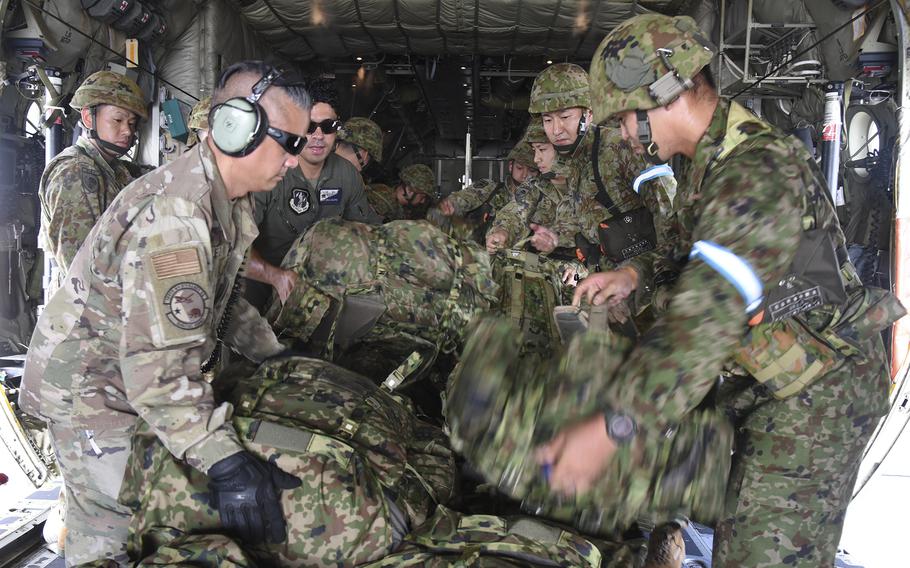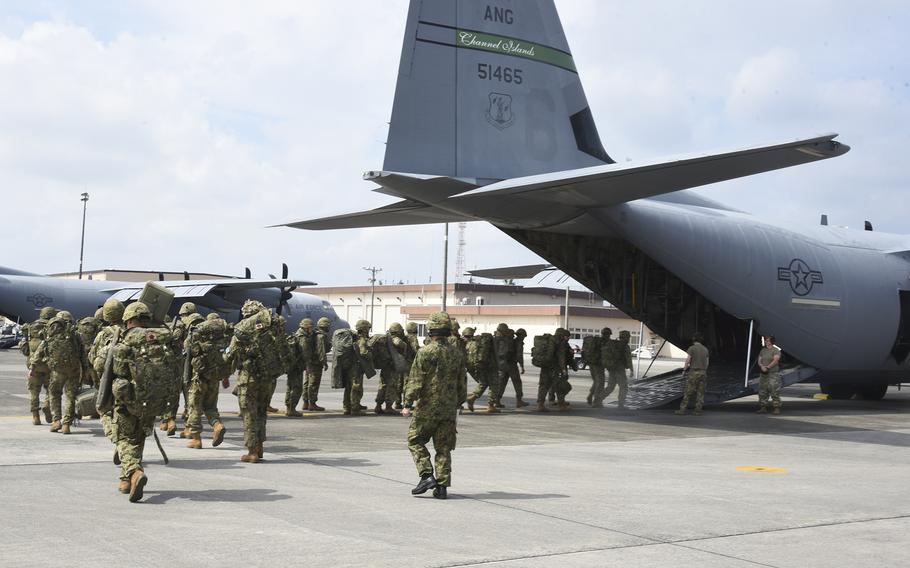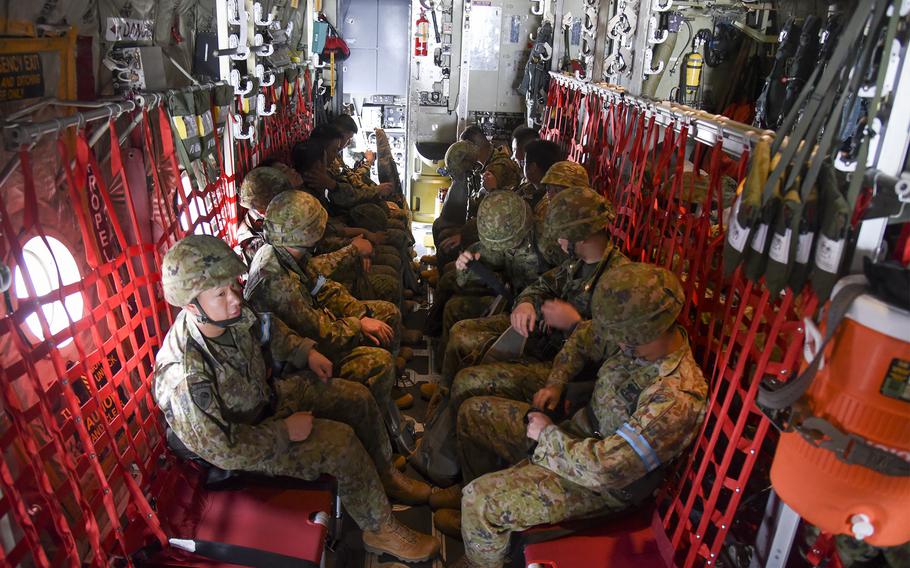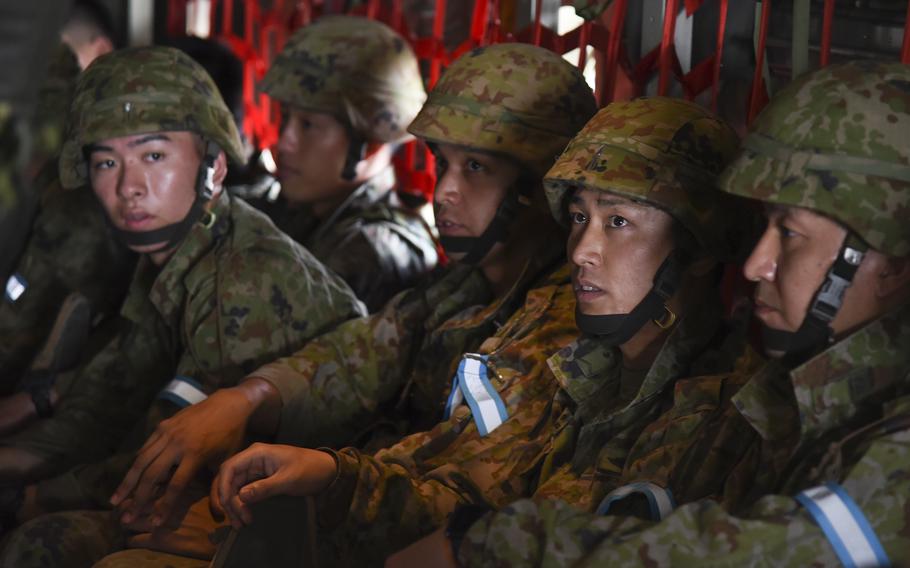
Japan Ground Self-Defense Force soldiers embark on a U.S. C-130J Super Hercules during a Valiant Shield exercise at Yokota Air Base, Japan, on Saturday, June 15, 2024. (Kelly Agee/Stars and Stripes)
YOKOTA AIR BASE, Japan – Propellers whirled as Japanese paratroopers and American special operations airmen loaded onto three C-130J Super Hercules tactical airlifters Saturday at this airlift hub in western Tokyo.
The troops, headed for northeast Japan, were among 10,000 participating in Valiant Shield, a biennial drill going on this month in Japan and on Guam, the Northern Mariana Islands and Palau.
The drills, which began June 7 and wrap up Tuesday, involve Japanese forces for the first time.
“The huge piece (of Valiant Shield) this year is that it is now multinational,” Col. Andrew Roddan, commander of Yokota’s 374th Airlift Wing, said as the U.S. planes and paratroopers of Japan’s 1st Airborne Brigade prepared to takeoff nearby.
The 70-80 Japanese soldiers had planned to parachute onto Japan’s northern island of Hokkaido but clouds over the drop zone near Chitose meant they went to Misawa Air Base in northeast Japan, instead.

Japan Ground Self-Defense Force soldiers board a U.S. C-130J Super Hercules during a Valiant Shield exercise at Yokota Air Base, Japan, on Saturday, June 15, 2024. (Kelly Agee/Stars and Stripes)
The operation included U.S. loadmasters and Japanese safety personnel, Roddan said.
“That is about as integrated as you can be,” he said. “It is operating as one package.”
The wing’s role during Valiant Shield involves moving people and gear with the C-130Js and C-12 Huron transports, Roddan said.
“We are providing mobility to the joint force so we can move whatever needs to be moved wherever it needs to be moved,” he said.
The planes involved in Saturday’s flight included one from Yokota’s 36th Airlift Squadron and two from the California Air National Guard’s 115th Airlift Squadron, according to Capt. Trent Fleener, a pilot with the squadron.
During Valiant Shield the C-130Js have also been to Kadena Air Base, Okinawa, and Marine Corps Air Station Iwakuni, Matsushima Air Field and Hachinohe Air Base on Honshu, the largest of Japan’s four main islands, he said.

Japan Ground Self-Defense Force soldiers prepare for takeoff on a U.S. C-130J Super Hercules during a Valiant Shield exercise at Yokota Air Base, Japan, on Saturday, June 15, 2024. (Kelly Agee/Stars and Stripes)
The planes were scheduled to visit Matsushima on Monday to practice hot refueling, a term for gassing up aircraft while their engines continue turning, Fleener said.
American forces involved in Valiant Shield include more than 20 surface ships and 200 aircraft, U.S. Pacific Fleet spokesman Chris Loundermon said by email Monday.
The training includes maritime interdiction, counter-air operations, anti-submarine warfare, intelligence, surveillance, reconnaissance and command and control, Navy Lt. Cmdr. Haider Mullick, one of the exercise’s directors, told Stars Stripes earlier this month.
This year’s exercise comes less than a month after China wrapped its own, smaller-scale exercise, Joint Sword 2024A, around Taiwan.
Beijing launched the exercise to dissuade Taiwan “separatist forces seeking ‘independence,’” according to a statement from China’s Eastern Theater Command.
Joint Sword began May 23, three days after Taiwan inaugurated President Lai Ching-Te. In his inauguration speech, Lai called on China to “face the reality of [Taiwan’s] existence, respect the choices of the people of Taiwan.”
China views Taiwan, a functional democracy, as a breakaway province that must be reunified with the mainland, by force if necessary.

Japan Ground Self-Defense Force soldiers prepare for takeoff on an C-130J Super Hercules during a Valiant Shield exercise at Yokota Air Base, Japan, on Saturday, June 15, 2024. (Kelly Agee/Stars and Stripes)